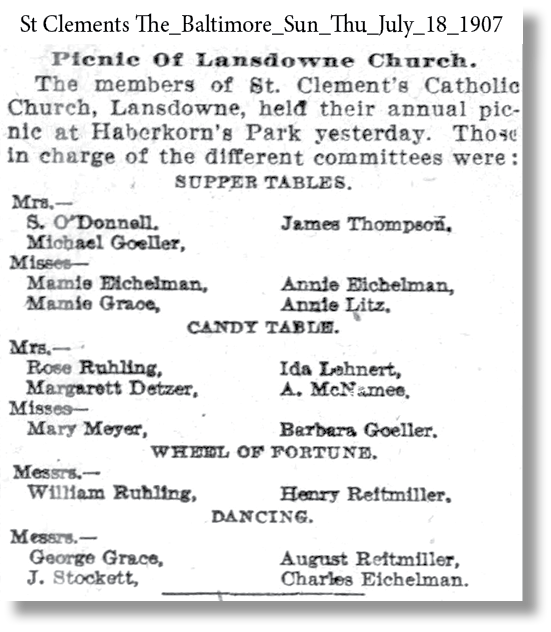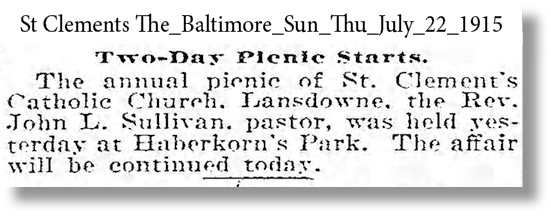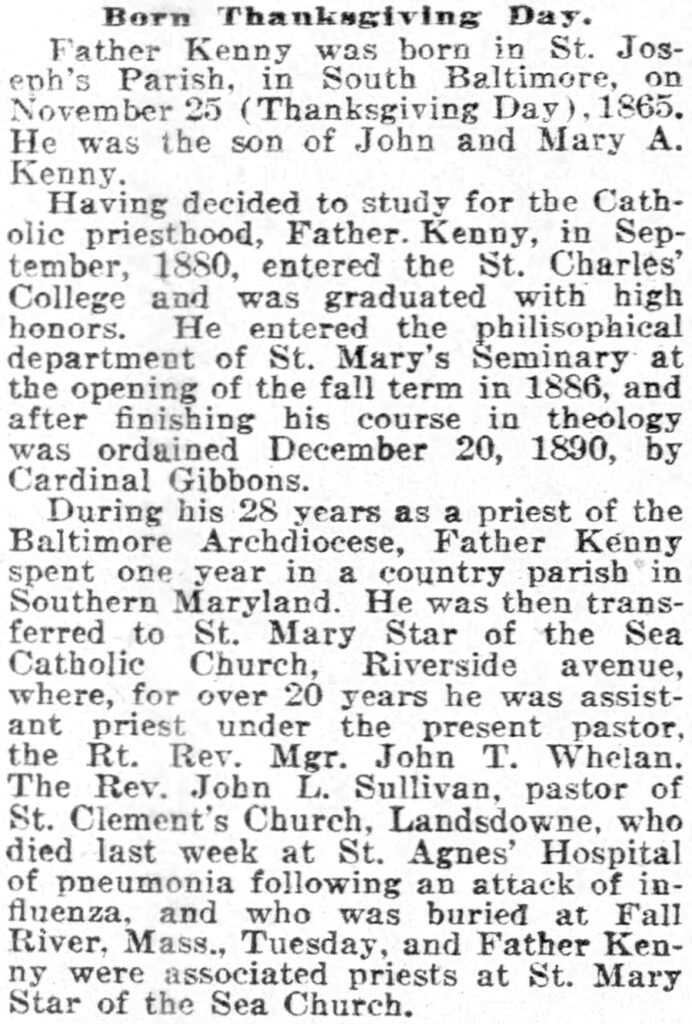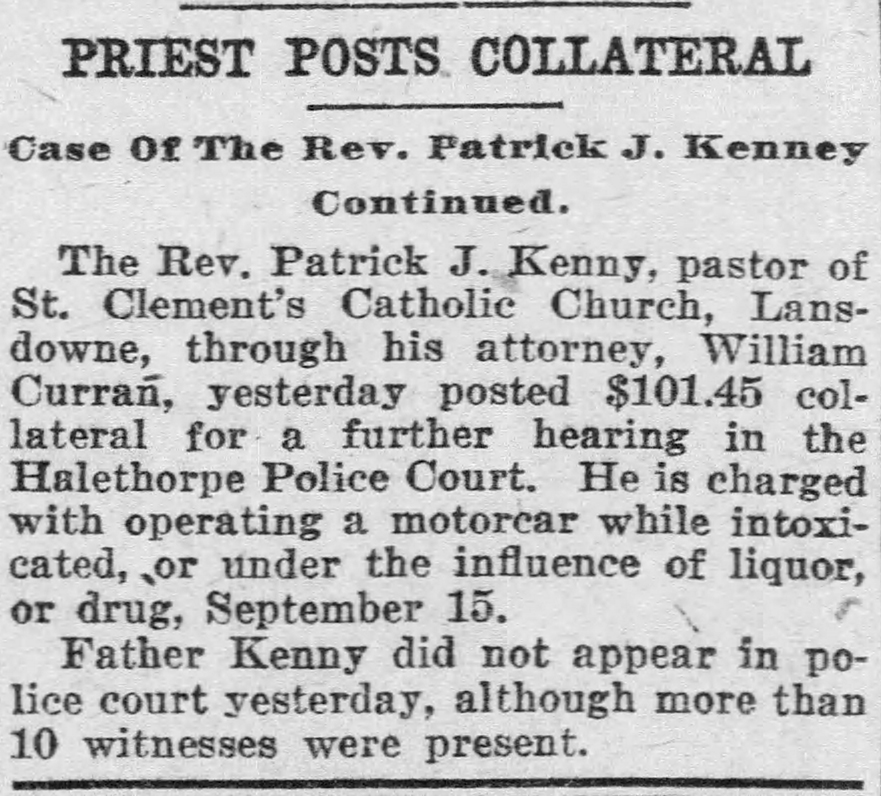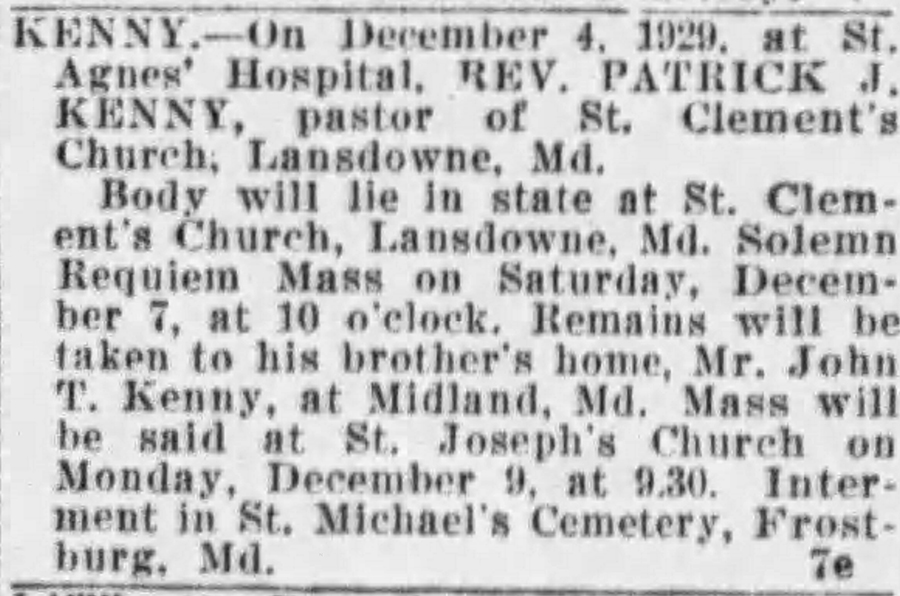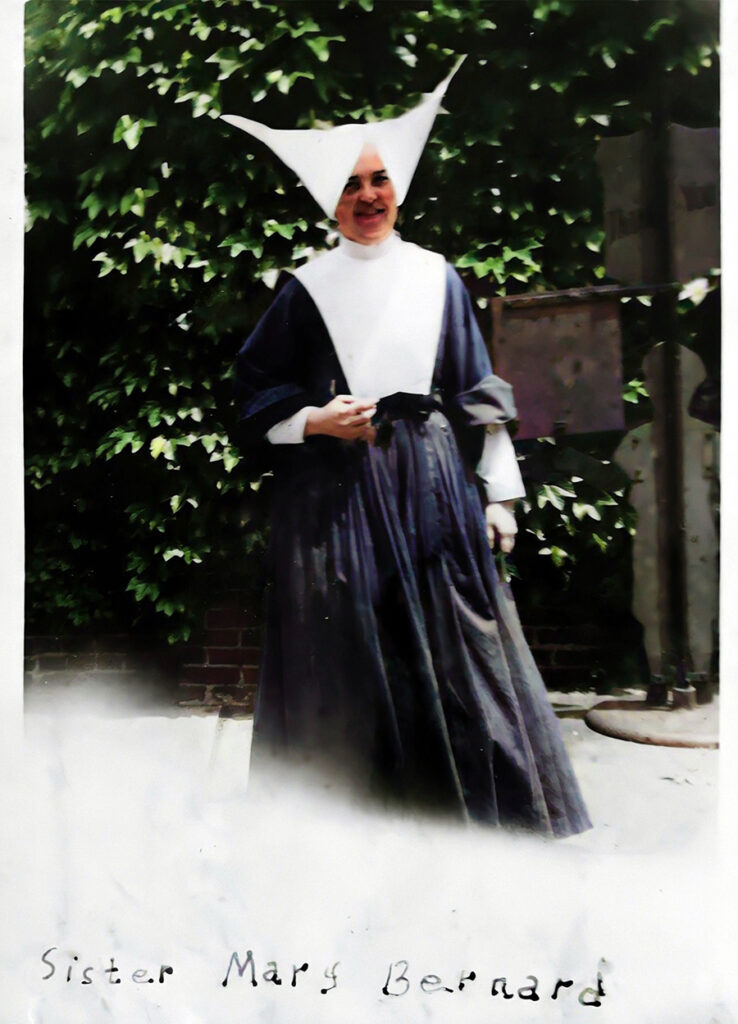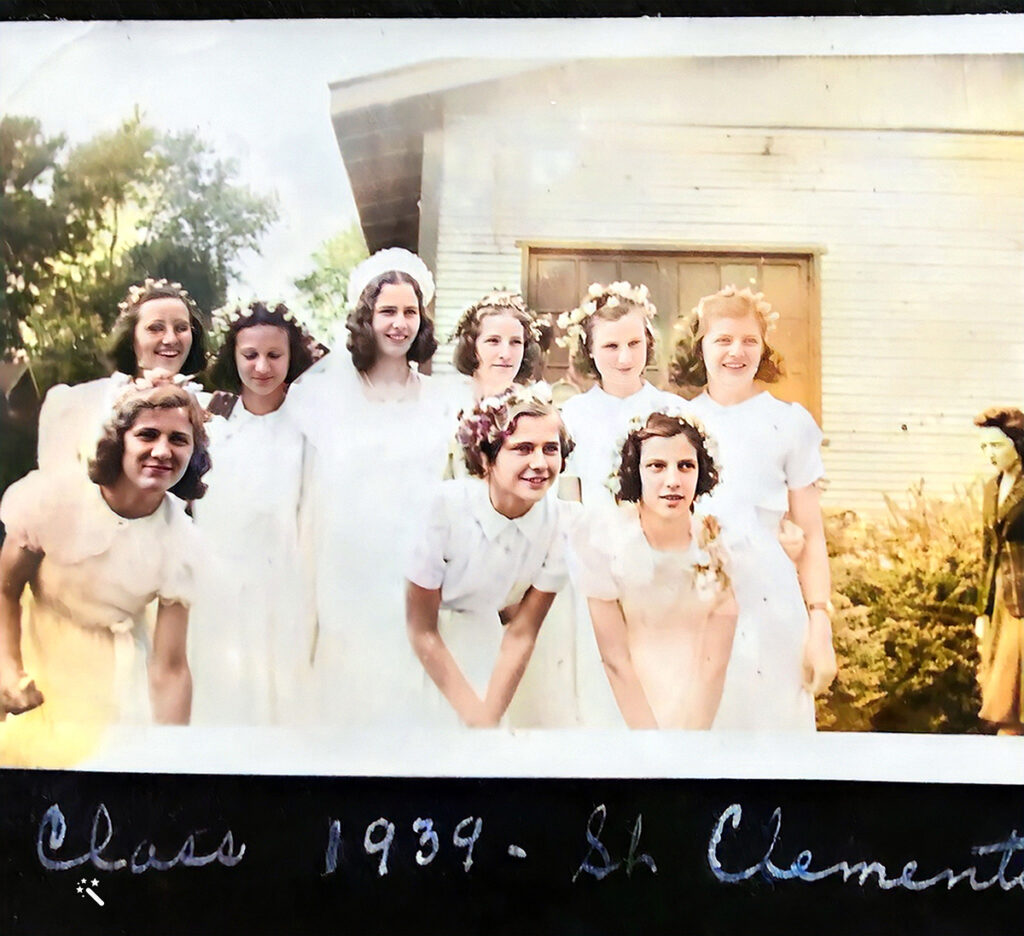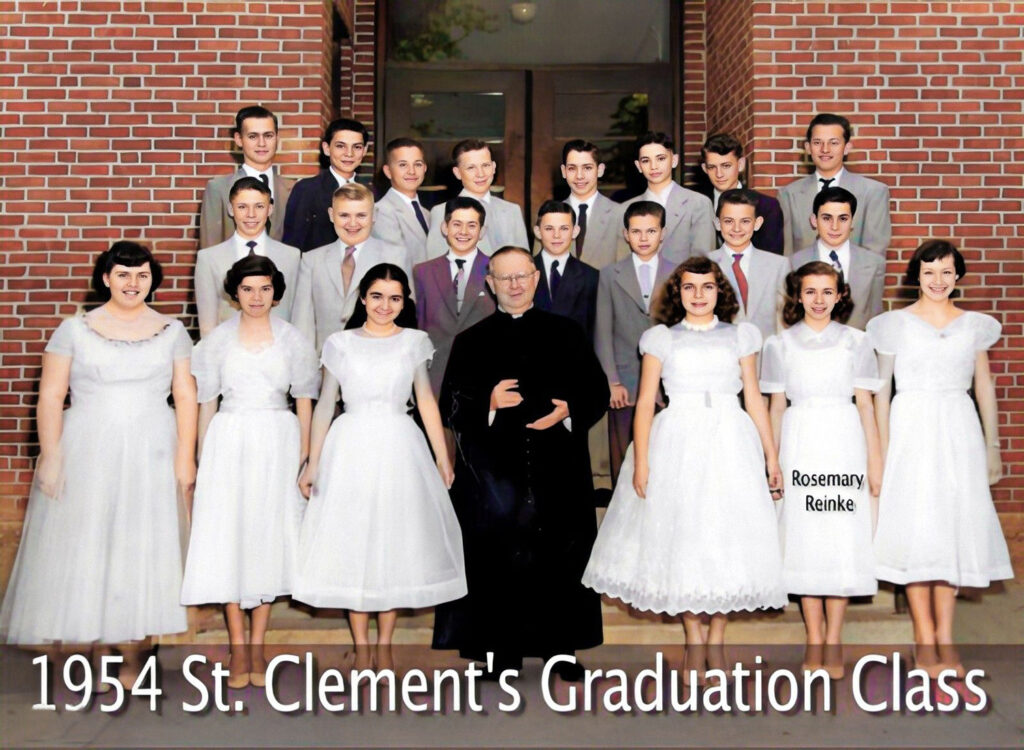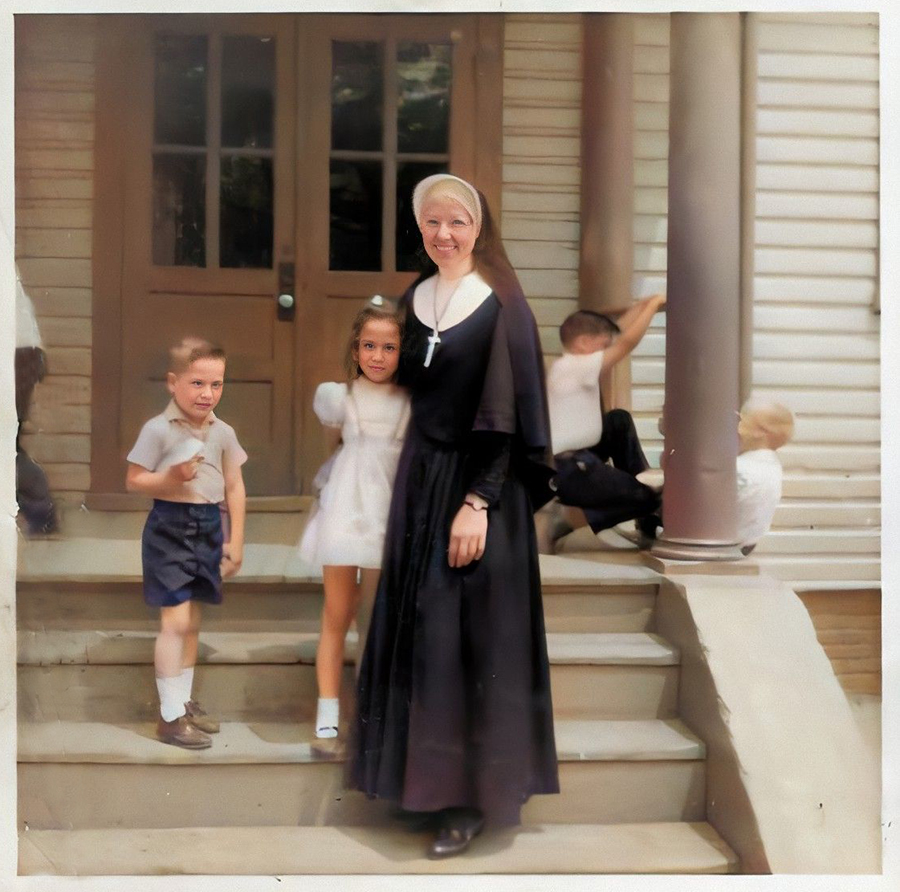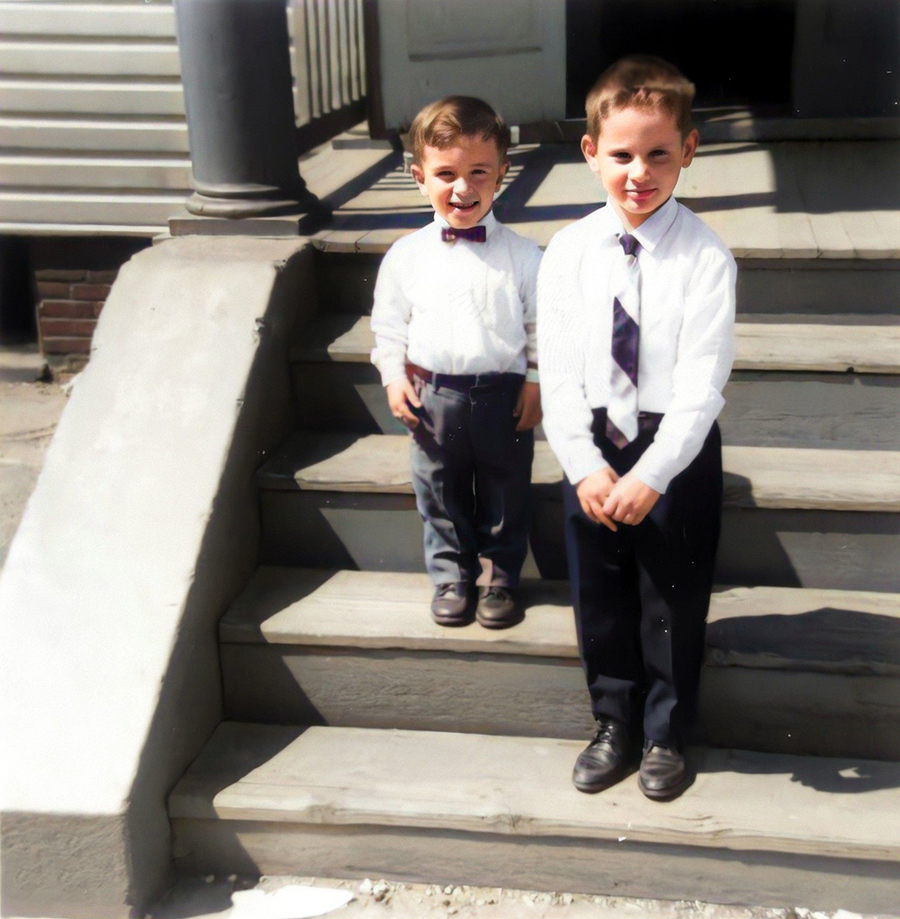St. Clement's Church and Parish History
Acknowledgments
The following information was taken from:
History of St. Clement’s Parish – Early History of Lansdowne, retrieved 15 January 2016
[https://docplayer.net/21803271-History-of-st-clement-s-parish.html]The images were added from social media and various online as well as personal sources.
Early History of St. Clement’s Parish
In the late 1800’s there were approximately six Catholic families in the Lansdowne area who had to use their own horse and buggy to attend Sunday Mass at St. Jerome’s Church in Baltimore. Because they found transportation difficult, they approached the pastor of St. Jerome’s, Rev. James P. Holden, to see whether it was possible to have a mission church established in Lansdowne. During that time the priests from St. Jerome’s traveled by horse to the Catholic families as far west as Halethorpe and Elkridge to bring the sacraments. However, in those days a horse was considered a luxury item. Most of the time, the priests walked to their destination. After some negotiation, Father Holden was successful in getting a 100’ x 200’ building lot, a donation from the Lansdowne Building Lot Company for the construction of a Church. (The present site of the Church and Rectory marks the location of the first church.) The corner stone for the red brick church was laid in the spring of 1891 and was completed about the middle of June in that year. (Site creator’s observation: when you hover over the image of the church above, the fire hydrant is in exactly the same place as present day) From the parish records we find the following article describing the cornerstone ceremonies:
A New Catholic Church at Lansdowne 1891 The Ceremonies
The cornerstone of the new Catholic Church at Lansdowne was laid yesterday afternoon with impressive ceremony. A large train left Camden Station at 2 P.M., bearing a number of Catholic organizations and others to Lansdowne. Headed by Bockman Brothers Band, John P. Hoffman leader, the organizations marched from the station to the new church, a distance of about a quarter of a mile. The following organizations were in line: Sts. Cyril and Methodius of St. Stanislaus Koska Church, Anton Literski commanding eighty men; Branch No. 6 St. Jerome’s Beneficial Society, Arthur J. Kirwin commanding eighty men, assisted by James O. Grady; Monsignor McManus’ Lyceum, Francis P. Kelly commanding thirty men; Knights of St. Adelbert, John J. Matni commanding fifty men; St. Joseph’s Society, Lawrence Stofanski commanding one hundred men. All the organizations were arrayed in their finest accoutrements; and, among the bright banner flying over them, the most beautiful perhaps was the American flag. The clergy, choir, sanctuary boys, acolytes and other attendants were in a cottage near the new church when the train arrived. They were escorted to the church by the cavalcade. Rev. James P. Holden, pastor of St. Jerome’s Church, assumed the place of dignity in the procession, the last in line. He wore a gold-colored cope.
 The other clergymen in line were Rev. Thomas J. Broydrick, pastor of St. Martin’s; Rev. Joseph L. Barry, pastor of St. Joseph’s; Rev. Charles Darner, pastor of the Church of the Holy Cross; Rev. Peter Chowanice, pastor of Holy Rosary Church; Rev. Joseph Skretpy, assistant pastor of St. Stanislaus and Rev. J. Powers of Chicago. The cornerstone was laid by Father Holden. Father Broydrick made an address in English and Father Darner in German. The choir was composed of choir members from St. Jerome and the Cathedral, Mr. John Veight directing. The committee of arrangements was composed of John P. Ruth, chairman, John Eichelman, assistant chairman, Ulrich Mueller, Martin Doetzer, Sebastian Schaub, George Ochs, John Heffner, J. Himmer, William J. Gratendieck, F. Blank, J. Dockman and James Gehring. Monsignor McColgan was to have laid the stone in the absence of Cardinal Gibbons but was unable to be present on account of feeble health. Between two and three thousand persons were present at the ceremony. Mr. C. David Lukins, president of the Lansdowne Building Lot Company, distributed one thousand free tickets at Camden Station. Many persons from the country around drove to the church. Sergeant Ryan of the Central District and a squad of policemen were detailed to preserve order, but this was an unnecessary precaution as perfect order prevailed.
The other clergymen in line were Rev. Thomas J. Broydrick, pastor of St. Martin’s; Rev. Joseph L. Barry, pastor of St. Joseph’s; Rev. Charles Darner, pastor of the Church of the Holy Cross; Rev. Peter Chowanice, pastor of Holy Rosary Church; Rev. Joseph Skretpy, assistant pastor of St. Stanislaus and Rev. J. Powers of Chicago. The cornerstone was laid by Father Holden. Father Broydrick made an address in English and Father Darner in German. The choir was composed of choir members from St. Jerome and the Cathedral, Mr. John Veight directing. The committee of arrangements was composed of John P. Ruth, chairman, John Eichelman, assistant chairman, Ulrich Mueller, Martin Doetzer, Sebastian Schaub, George Ochs, John Heffner, J. Himmer, William J. Gratendieck, F. Blank, J. Dockman and James Gehring. Monsignor McColgan was to have laid the stone in the absence of Cardinal Gibbons but was unable to be present on account of feeble health. Between two and three thousand persons were present at the ceremony. Mr. C. David Lukins, president of the Lansdowne Building Lot Company, distributed one thousand free tickets at Camden Station. Many persons from the country around drove to the church. Sergeant Ryan of the Central District and a squad of policemen were detailed to preserve order, but this was an unnecessary precaution as perfect order prevailed.
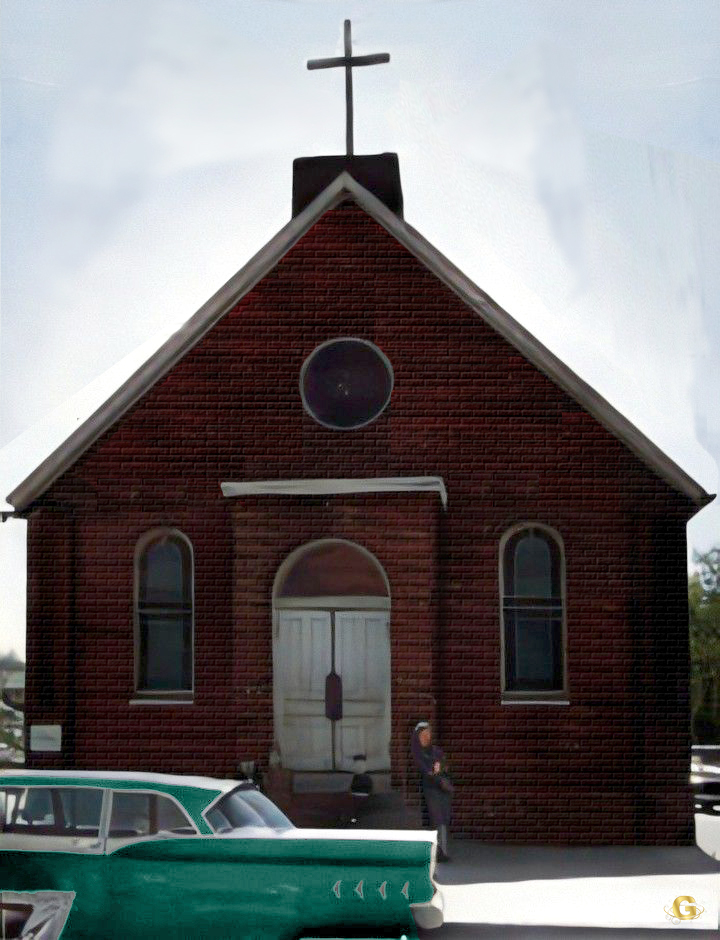 The ground upon which the new church is being built has a frontage of 100 feet and a depth of 200 feet and was donated by the Lansdowne Building Lot Company. The church will be thirty feet across and sixty feet deep and, when completed, will contain seats for three hundred persons. The super-structure will be brick resting on a stone foundation. It will cost about $4,000. Mr. Lukins assisted in raising subscriptions to the amount of $1,200 toward paying for the church. The church will be completed about the middle of June. Mr. Robert C. Boone of Hampden was the contractor for the masonry and Messrs. Muroney & Kalb are the builders. In a box in the cornerstone will be placed a copy of today’s American and some coins.
The ground upon which the new church is being built has a frontage of 100 feet and a depth of 200 feet and was donated by the Lansdowne Building Lot Company. The church will be thirty feet across and sixty feet deep and, when completed, will contain seats for three hundred persons. The super-structure will be brick resting on a stone foundation. It will cost about $4,000. Mr. Lukins assisted in raising subscriptions to the amount of $1,200 toward paying for the church. The church will be completed about the middle of June. Mr. Robert C. Boone of Hampden was the contractor for the masonry and Messrs. Muroney & Kalb are the builders. In a box in the cornerstone will be placed a copy of today’s American and some coins.
 Because St. Clement’s was a Mission of St. Jerome’s, Father Holden and Father Knell, his assistant, had to be transported by the parishioners to and from the Church each Sunday. A few sisters from St. Jerome’s also came each Sunday to teach Sunday school lessons to the children. Later, sisters from St. Agnes Hospital were brought to teach catechism classes and following them the newly formed Mission Helper Sisters took up this vital task.
Because St. Clement’s was a Mission of St. Jerome’s, Father Holden and Father Knell, his assistant, had to be transported by the parishioners to and from the Church each Sunday. A few sisters from St. Jerome’s also came each Sunday to teach Sunday school lessons to the children. Later, sisters from St. Agnes Hospital were brought to teach catechism classes and following them the newly formed Mission Helper Sisters took up this vital task.
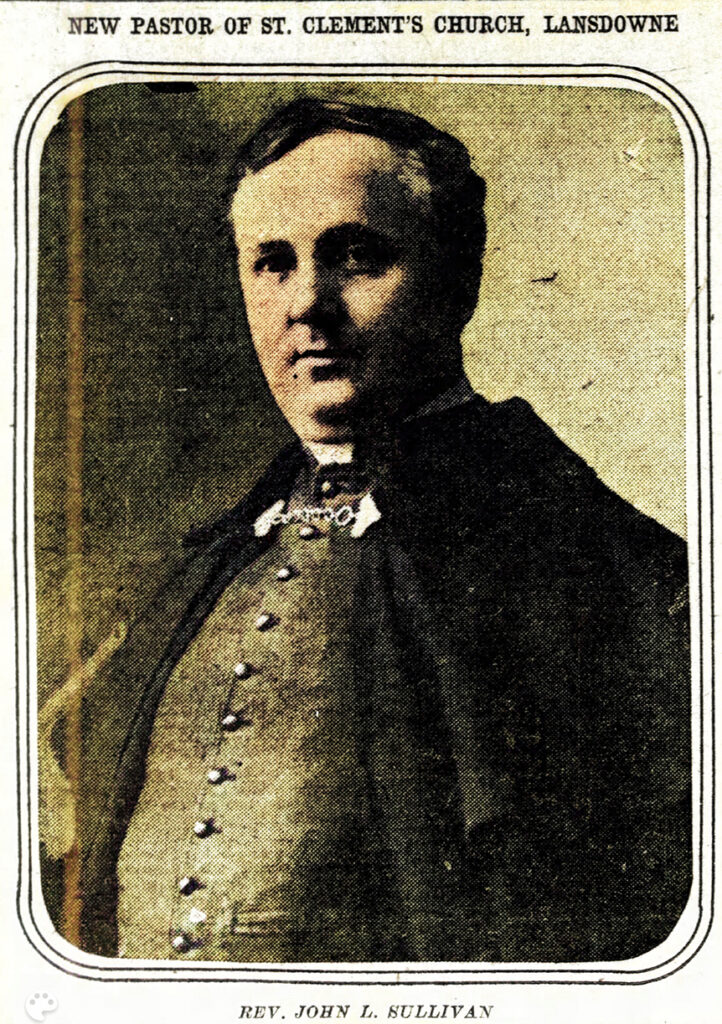 The first Pastor, Rev. Michael P. Sullivan, was appointed in 1895. His rectory was a small house standing where the present convent is located. Little is know about the early history of the parish. On February 9, 1918 a fire, believed to have been started by an overheated stove, destroyed the records and the rectory. After the fire Father Sullivan purchased another house which was located at the corner of First and Washington Avenues, now a fenced grass plot. He did not enjoy his new residence very long because on October 17, 1918 he died. The fire and the death of Father Sullivan marked 1918 as an eventful year in the early days of the parish.
The first Pastor, Rev. Michael P. Sullivan, was appointed in 1895. His rectory was a small house standing where the present convent is located. Little is know about the early history of the parish. On February 9, 1918 a fire, believed to have been started by an overheated stove, destroyed the records and the rectory. After the fire Father Sullivan purchased another house which was located at the corner of First and Washington Avenues, now a fenced grass plot. He did not enjoy his new residence very long because on October 17, 1918 he died. The fire and the death of Father Sullivan marked 1918 as an eventful year in the early days of the parish.
 After Father Sullivan’s death, Father Elbert was sent from St. Mary’s Seminary of Paca Street and served as administrator until he was later appointed Pastor. Father Elbert was transferred and replaced by a Father Flemming who too was soon transferred and replaced by Rev. Patrick Joseph Kenny in 1922. In four years, there were four pastors, a time of unsettling changes at St. Clement’s.
After Father Sullivan’s death, Father Elbert was sent from St. Mary’s Seminary of Paca Street and served as administrator until he was later appointed Pastor. Father Elbert was transferred and replaced by a Father Flemming who too was soon transferred and replaced by Rev. Patrick Joseph Kenny in 1922. In four years, there were four pastors, a time of unsettling changes at St. Clement’s.
Father Kenny (Site creator’s note: this was the first Father Kenny) was remembered as a dynamic individual largely responsible for the beginning of St. Clement’s School. In 1924 he sought the help of the Sisters of Providence. Later, three Sisters of Providence from the Washington, D.C. area visited St. Clement’s with the intention of establishing another school for their order in the cast. They consented to establish a parish school and immediately eight women in the parish formed a School Society. They were instrumental along with Father Kenny in getting the funds together for a school. Baltimore County owned a one room school house on the site of the present parking lot and at about this time the county government was building a larger, modern school necessitated by the increase in the population of the area. Fortunately, Father Kenny was able to negotiate a good price for this old school; and through the work of parishioners who were carpenters, the wooden structure was expanded. Also, Father Kenny purchased a home for the sisters located on the land where the present school buildings stand. The chapel for the sisters was completed on September 8, 1927 when the sisters celebrated their first Mass at home. When the school opened on September 13, 1927, there were 146 pupils registered with grades one through eight. Since the staff consisted of only four teaching sisters and one music teacher, there were two grades to each class room. The first Superior-principal was Sister St. Cyrilla.
 Sometime during the early years of the school, it was remembered that Father Kenny received threats from the local Ku Klux Klan for some unknown reason. They claimed that they would burn down the school. It was reported that Father Kenny told the Klan leaders that he was not concerned about the threat because the property was well insured and that the Church would receive a large amount of money if they carried out their intention. As a result, the K.K.K. left this property alone; however, they did burn a few crosses in the area. Father Kenny later told parishioners that the school was not insured, that his remarks were only a ploy to counter the Klan.
Sometime during the early years of the school, it was remembered that Father Kenny received threats from the local Ku Klux Klan for some unknown reason. They claimed that they would burn down the school. It was reported that Father Kenny told the Klan leaders that he was not concerned about the threat because the property was well insured and that the Church would receive a large amount of money if they carried out their intention. As a result, the K.K.K. left this property alone; however, they did burn a few crosses in the area. Father Kenny later told parishioners that the school was not insured, that his remarks were only a ploy to counter the Klan.
 Father Kenny is also remembered for his excellent sermons. He traveled to Pennsylvania, Washington, D.C. and Virginia on speaking engagements to earn money for the parish. He also made arrangements with the B & O to bring people from Halethorpe and Relay to Lansdowne for Mass. Father Kenny moved into another house on First Avenue where his sister, Sarah, assisted him as housekeeper.
Father Kenny is also remembered for his excellent sermons. He traveled to Pennsylvania, Washington, D.C. and Virginia on speaking engagements to earn money for the parish. He also made arrangements with the B & O to bring people from Halethorpe and Relay to Lansdowne for Mass. Father Kenny moved into another house on First Avenue where his sister, Sarah, assisted him as housekeeper.
During the early years the social events of the parish were held at Havercorn’s Hall which was located across from the Lansdowne Inn on Hammonds Ferry Road. It was remembered that a Miss Warnner visited all of the houses in the parish to ask for donations and help for the social events. These events were popular and well attended, and much money was raised for the church and school. Later in the 1920’s the parish set up a dancing pavilion on the site of the present church hall. At first the pavilion was simply a platform with a railing around it. For the dances an orchestra was hired, and the charge was 10 cents a dance. To provide for events during the cold weather months, parishioners added a roof and walls to the pavilion and a large hole was dug in the foundation for a heating unit. Parishioners did all the work. Soon after the completion of this project, their zeal and talent resulted in another structure, a garage for the pastor’s car on the site of the present convent. This garage served a dual purpose because it also functioned as a kitchen for parish dinners. It was remembered that during the early days of the parish sour beef dinners were popular and served in two styles.
Click the image for a larger view.
Recent History of St. Clement’s Parish
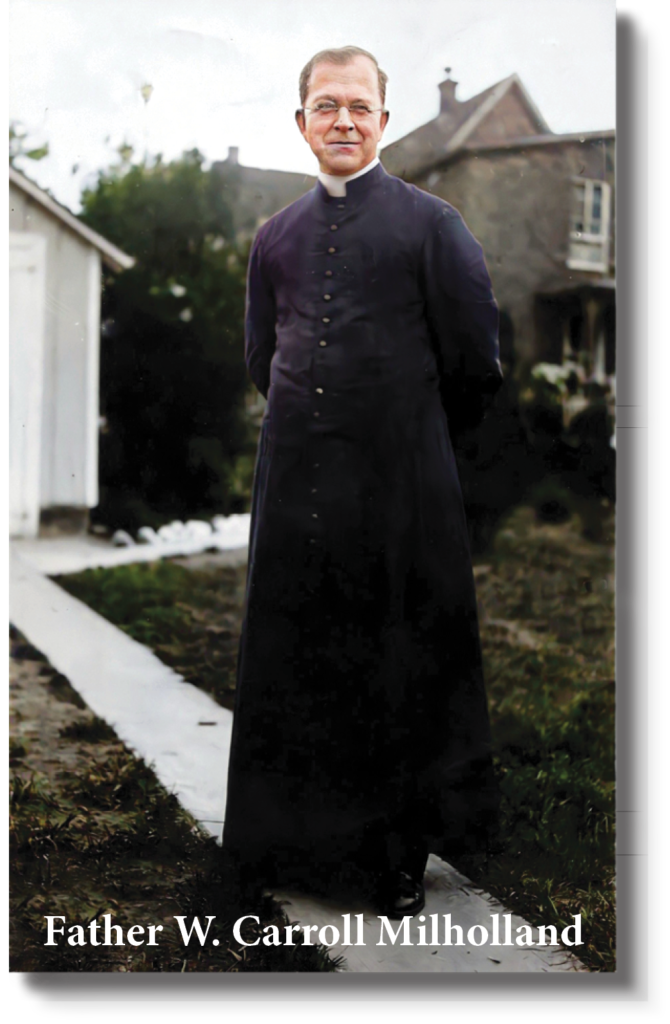 1929 was an eventful year not only in the country, but also in St. Clement’s Parish. On February 6, Father Kenny who had been in poor health was sent to St. Agnes Hospital. In his absence, the Redemptorist Fathers from St. Michael’s in Baltimore took up the ministry to the parish. During their time, two Redemptorists from Annapolis, Fathers McCann and Holland, conducted a very successful mission for the parish in late May. Also during the tenure of the Redemptorist, eighty children received the Sacrament of Confirmation, Bishop McNamara being the celebrant.
1929 was an eventful year not only in the country, but also in St. Clement’s Parish. On February 6, Father Kenny who had been in poor health was sent to St. Agnes Hospital. In his absence, the Redemptorist Fathers from St. Michael’s in Baltimore took up the ministry to the parish. During their time, two Redemptorists from Annapolis, Fathers McCann and Holland, conducted a very successful mission for the parish in late May. Also during the tenure of the Redemptorist, eighty children received the Sacrament of Confirmation, Bishop McNamara being the celebrant.
Though he was still in poor health, Father Kenny made an unusual effort to return to the parish. The occasion for his return was the graduation of fourteen students from St. Clement’s School on June 16. His health continued to deteriorate until he died on December 4 at St. Agnes Hospital. He was buried from St. Clement’s Church with a Solemn High Mass and then was carried by a special train to Western Maryland, where he was laid to rest.
Upon the death of Fr. Kenny, Fr. Arthur Fleming took over the leadership of the parish as temporary pastor. He served but a short time when Fr. W. Carroll Milholland of St. Mary’s Parish was appointed pastor on July 6, 1930. He was remembered as the priest who established a unique program in scouting called Sea Scouts. It brought many enriching experiences to a number of youth. In 1943 Father Milholland became ill and was hospitalized. Thinking that his hospital stay would last only a few days, he made arrangements to have the sisters transported daily for Mass. The illness persisted however; and on January 29, 1944 Fr. Milholland died.
Click the image for a larger view.

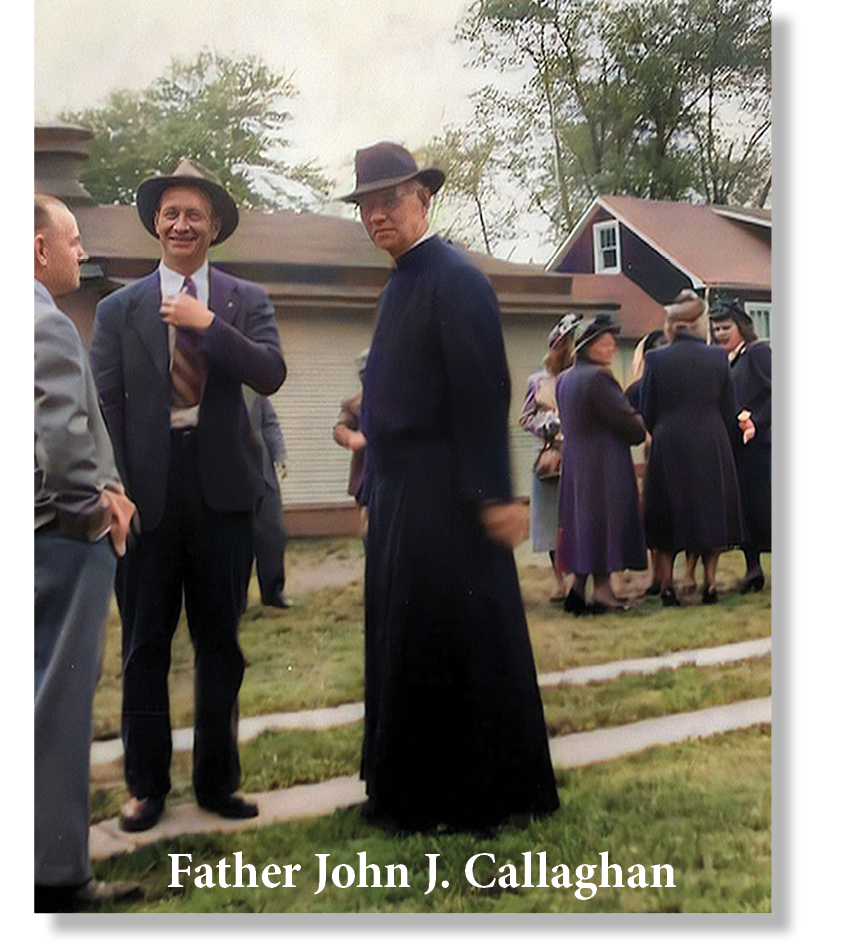 For several months, Father Shehan, a Dominican priest, tended the parish until a permanent pastor could be found. Finally on November 22, Fr. S. F. Coyle, a priest of the Society of St. Sulpice, was appointed administrator. It was not until 1945 that a permanent pastor was appointed when Fr. John J. Callaghan came to St. Clement’s. During his time, the parish continued to grow as the area expanded in the post war era. In 1950 Fr. Callaghan was replaced by Fr. Cornelius J. Byrnes.
For several months, Father Shehan, a Dominican priest, tended the parish until a permanent pastor could be found. Finally on November 22, Fr. S. F. Coyle, a priest of the Society of St. Sulpice, was appointed administrator. It was not until 1945 that a permanent pastor was appointed when Fr. John J. Callaghan came to St. Clement’s. During his time, the parish continued to grow as the area expanded in the post war era. In 1950 Fr. Callaghan was replaced by Fr. Cornelius J. Byrnes.
As divine providence would have it, Fr. Byrnes guided the parish for eighteen years. It was a time in which the parish experienced great growth as part of the continual development of the Baltimore Metropolitan area. His first Mass as newly appointed pastor was celebrated on Our Lady’s birthday, September 8. In 1951, he began what was to characterize his pastorate, the role of the building priest. That year he broke ground for the building of three classrooms. Construction began on June 9 and went so rapidly that it was completed for the opening of school in September (presently the First Avenue entrance to the school).
The school saw many changes, improvements and additions. In September of 1955 the first lay teachers joined the religious faculty of all nuns. Two years later on January 7, 1957, an addition of five classrooms and a temporary church on the first floor of the school was begun (presently the Washington Avenue entrance to the school). Fr. Byrnes celebrated the first Mass in the temporary church in October of that year.
In May, 1958, Fr. Byrnes secured permission from Archbishop Keough to build a convent. Ground was broken on August 14 and was soon followed by a grand Open House on January 25, after which the sisters moved into their lovely furnished convent. Fr. Byrnes blessed the sisters’ new home by celebrating the first Mass in the convent on January 31.
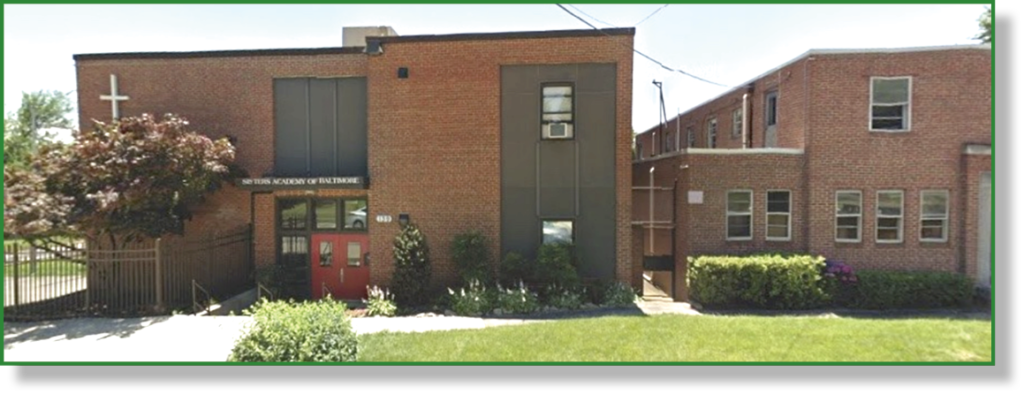 In short order, Fr. Byrnes was involved in another building project. The rapidly increasing school enrollment necessitated the addition of four classrooms on top of the existing First Avenue classrooms. After the completion of this project, Fr. Byrnes undertook another. In April of 1961, the hall was demolished and preparations begun for a new hall on that site. On October 15, the new hall was completed and officially opened with the Annual Turkey Dinner (this annual event started in 1942). Incidentally, the parish debt at that time amounted to $200,000.
In short order, Fr. Byrnes was involved in another building project. The rapidly increasing school enrollment necessitated the addition of four classrooms on top of the existing First Avenue classrooms. After the completion of this project, Fr. Byrnes undertook another. In April of 1961, the hall was demolished and preparations begun for a new hall on that site. On October 15, the new hall was completed and officially opened with the Annual Turkey Dinner (this annual event started in 1942). Incidentally, the parish debt at that time amounted to $200,000.
Fr. Byrnes embarked on yet another project. In November of 1965, the old church originally constructed in 1891, was demolished. This area made way for a playground and parking lot while Mass continued to be held in the temporary church, part of the school structure on the first floor.
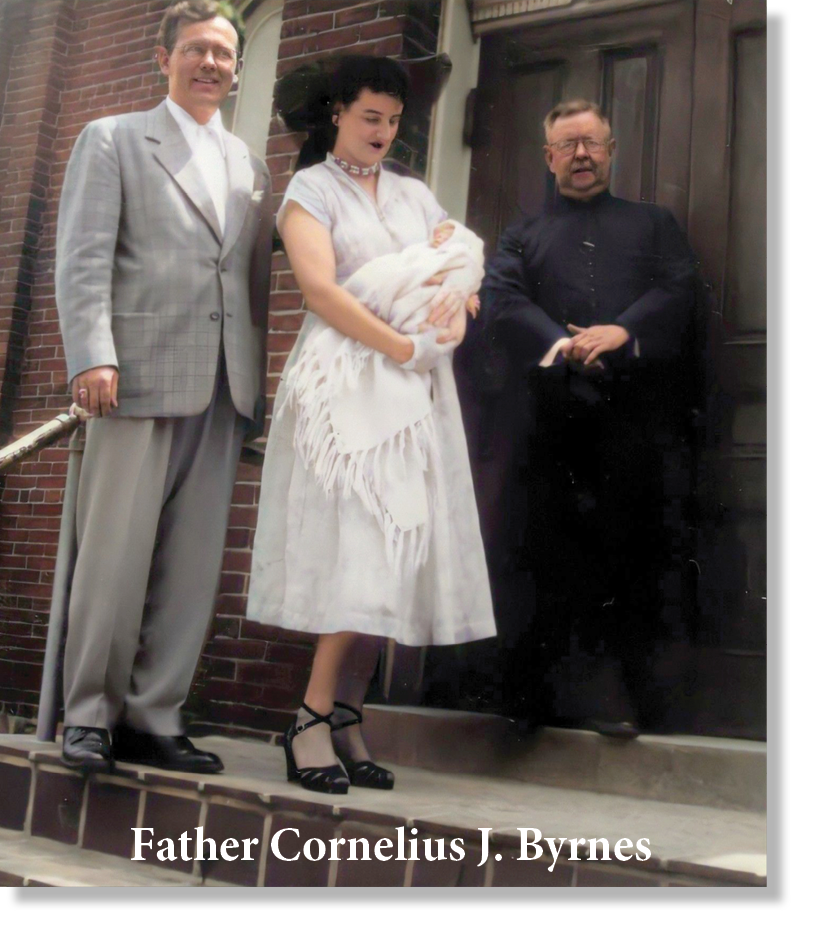 True to his role as the building priest, Fr. Byrnes began major construction in 1968. The hall was converted into a church and the temporary church was transformed into several classrooms and a school library. The old school was demolished in August, 1968 to become the present parking lot. In that same year plans were made for the construction of a new rectory and church. (The Garmer’s residence on First Avenue was the former rectory). Because of poor health Fr. Byrnes did not see these projects through to completion. The work passed on to a successor. The building priest died in 1969, buried from the hall just one month before the opening of the new church in October of ‘69.
True to his role as the building priest, Fr. Byrnes began major construction in 1968. The hall was converted into a church and the temporary church was transformed into several classrooms and a school library. The old school was demolished in August, 1968 to become the present parking lot. In that same year plans were made for the construction of a new rectory and church. (The Garmer’s residence on First Avenue was the former rectory). Because of poor health Fr. Byrnes did not see these projects through to completion. The work passed on to a successor. The building priest died in 1969, buried from the hall just one month before the opening of the new church in October of ‘69.
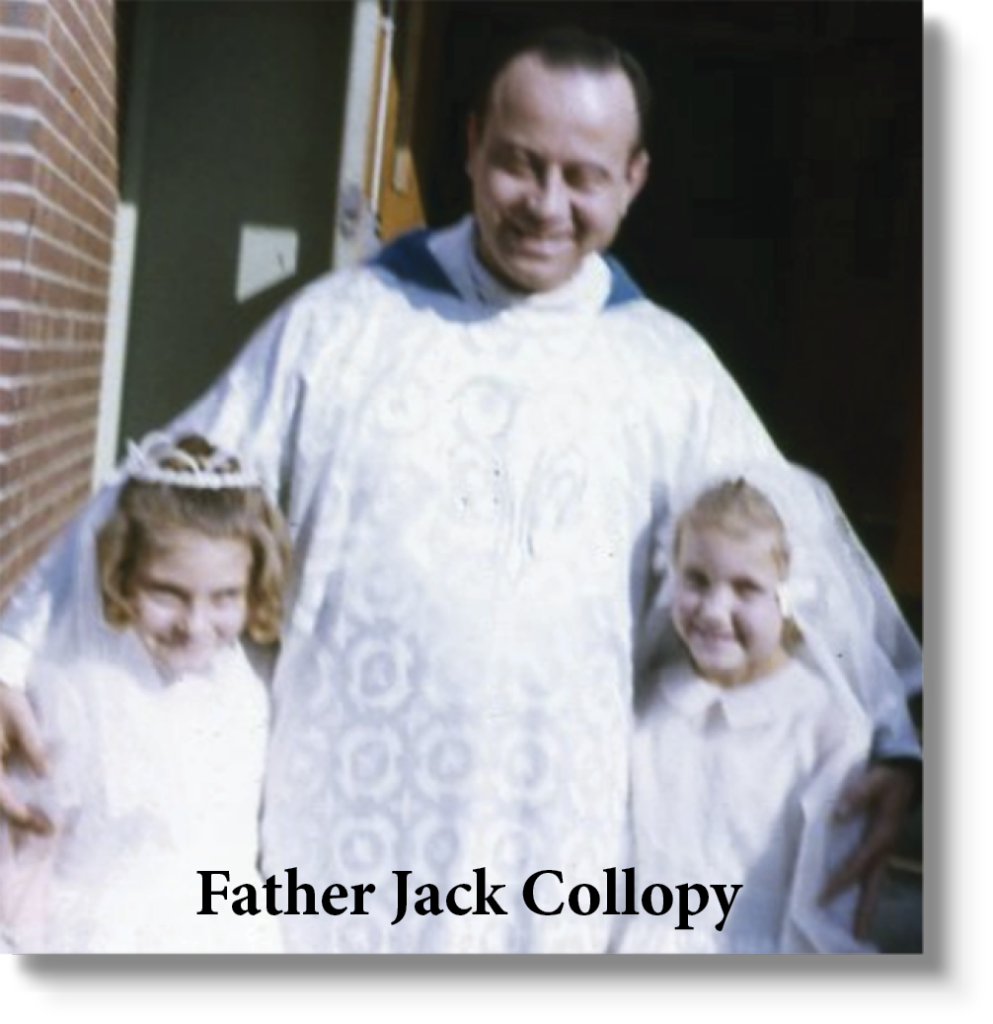 During this time of building there were four assisting priests working with Fr. Byrnes at various times. The first to come was Fr. Joseph Young from 1958 – 1965. His term was described as taking care of those little jobs that made for as smooth an operation as possible. Second was Fr. Jack Collopy from 1965 – 1969. His special outreach was to the youth of the parish. He started and moderated the CYO. Third was Fr. Joseph Maskell from 1965 – 1966. His official time as assistant was short since he moved on to another parish and served the diocese as a professional counselor.
During this time of building there were four assisting priests working with Fr. Byrnes at various times. The first to come was Fr. Joseph Young from 1958 – 1965. His term was described as taking care of those little jobs that made for as smooth an operation as possible. Second was Fr. Jack Collopy from 1965 – 1969. His special outreach was to the youth of the parish. He started and moderated the CYO. Third was Fr. Joseph Maskell from 1965 – 1966. His official time as assistant was short since he moved on to another parish and served the diocese as a professional counselor.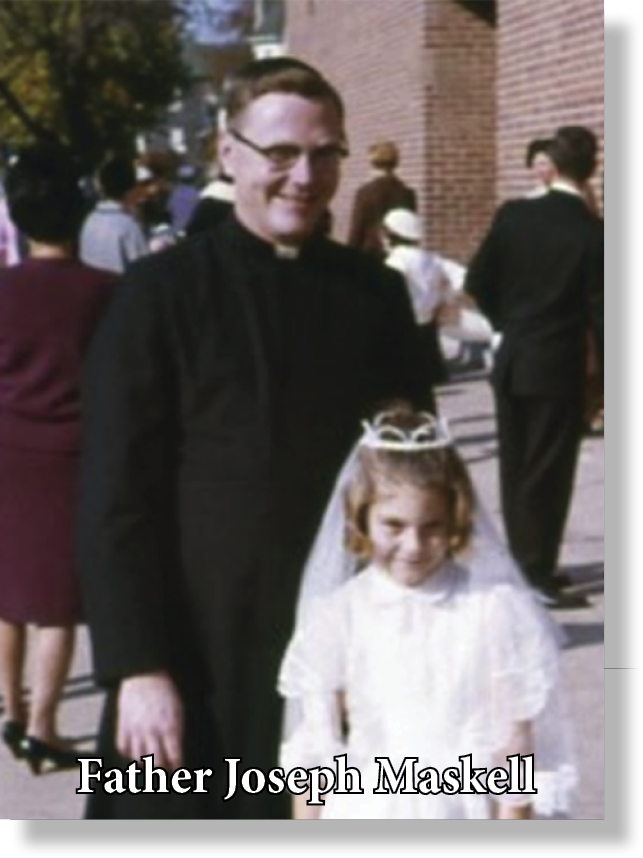 Later, from 1970 to 79, Fr. Maskell took up residence in St. Clement’s. While continuing his counseling work, Fr. Maskell regularly celebrated the sacraments in the parish and was moderator of the Boy Scouts. Fourth was Fr. Robert Linden from 1966 – 67. He was moderator of the CCD program for a short time and then left to join the St. James Society, working as a missionary in Peru. The fact that Fr. Byrnes needed the help of assistants simply reflected the reality of great growth during his pastorate.
Later, from 1970 to 79, Fr. Maskell took up residence in St. Clement’s. While continuing his counseling work, Fr. Maskell regularly celebrated the sacraments in the parish and was moderator of the Boy Scouts. Fourth was Fr. Robert Linden from 1966 – 67. He was moderator of the CCD program for a short time and then left to join the St. James Society, working as a missionary in Peru. The fact that Fr. Byrnes needed the help of assistants simply reflected the reality of great growth during his pastorate.
It was during the time of Fr. Byrnes that the parish experienced two distinct honors. First, Mary Ann Phelan, a graduate of St. Clement’s School, became a professed nun of the Sisters of Providence in 1958. She was later to become part of the school faculty as principal from 1972 – 1977. Second, Walter McGovern, also a graduate of St. Clement’s School, was ordained a priest of the Archdiocese of Baltimore in 1965. These two vocations to the religious life were seen as a blessing for all the prayers and labor of many parishioners.
 When Fr. Byrnes retired, St. Clement’s, so to speak, passed into another era. Fr. Francis Fortenbaugh was his successor and the pastor who brought to completion the building of the new rectory and church. Now was the time to direct more attention to the building of the faith in a time that was challenging to the church. With the help of Fr. Martin Feild, Fr. Fortenbaugh established the Parish Council, a new structure to involve greater lay participation. Not only a new structure but also a new ministry reflected the development of a changing church. In 1972, Mr. Norman Colson, a parishioner of St. Clement’s was ordained to the permanent deaconate to serve the parish. Also about this time another new ministry appeared on the scene.
When Fr. Byrnes retired, St. Clement’s, so to speak, passed into another era. Fr. Francis Fortenbaugh was his successor and the pastor who brought to completion the building of the new rectory and church. Now was the time to direct more attention to the building of the faith in a time that was challenging to the church. With the help of Fr. Martin Feild, Fr. Fortenbaugh established the Parish Council, a new structure to involve greater lay participation. Not only a new structure but also a new ministry reflected the development of a changing church. In 1972, Mr. Norman Colson, a parishioner of St. Clement’s was ordained to the permanent deaconate to serve the parish. Also about this time another new ministry appeared on the scene.
 Doctrine had been established in 1963 and was now coming into its own. Both priests recognized the need of help. Sr. Laurine Haley of the Sisters of Providence came in time to carry the CCD program further. Her association started in 1973 on a limited basis. Then in 1974 the new pastor, Fr. Joseph Kenney, hired Sr. Laurine as full time CCD Coordinator and appointed in 1976 Fr. Brendan Carr, newly ordained, as moderator of the CCD. The work of the CCD was passed on in 1978 to Sr. Corinne Manzi, S.N.D. and to Fr. Henry Milkowski. In 1980 the CCD changed it name to reflect the broader scope of the program to School of Religion for Christian Formation. The Second Vatican Council (1963 – 65) had called for a comprehensive program extending from the womb to the tomb.
Doctrine had been established in 1963 and was now coming into its own. Both priests recognized the need of help. Sr. Laurine Haley of the Sisters of Providence came in time to carry the CCD program further. Her association started in 1973 on a limited basis. Then in 1974 the new pastor, Fr. Joseph Kenney, hired Sr. Laurine as full time CCD Coordinator and appointed in 1976 Fr. Brendan Carr, newly ordained, as moderator of the CCD. The work of the CCD was passed on in 1978 to Sr. Corinne Manzi, S.N.D. and to Fr. Henry Milkowski. In 1980 the CCD changed it name to reflect the broader scope of the program to School of Religion for Christian Formation. The Second Vatican Council (1963 – 65) had called for a comprehensive program extending from the womb to the tomb.
Although the era of building was well behind, its presence was still experienced in small ways. In 1978, Fr. Kenney memorialized the building priest, Fr. Byrnes, by a three room addition to the hall. And soon afterwards, Fr. Kenney needed to make substantial roof repairs to several parish buildings.
No doubt, as in the past, the future building of St. Clement’s Parish will place many challenges before the people of the parish. And if history is any indication of the future, the religious and lay people will continue to meet these challenges in grand style through prayer and good works, the way of Jesus Christ.
Miscellaneous St. Clement's Memories






















